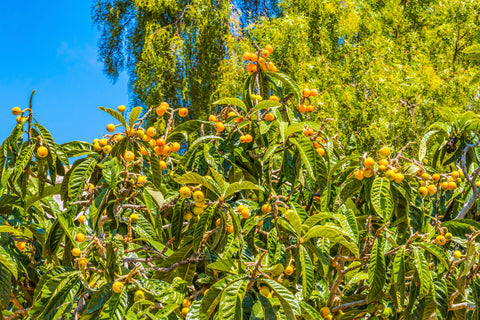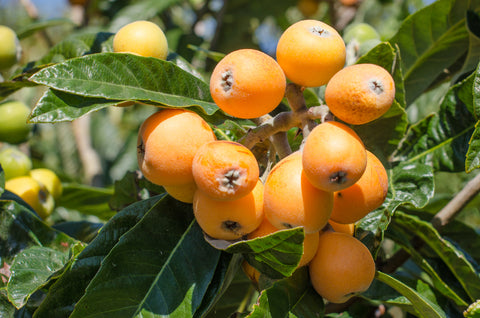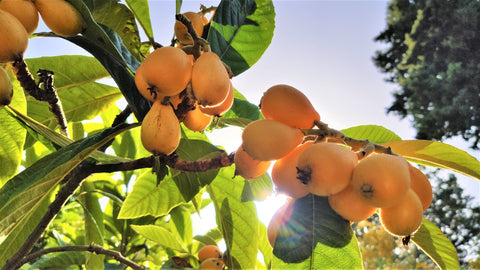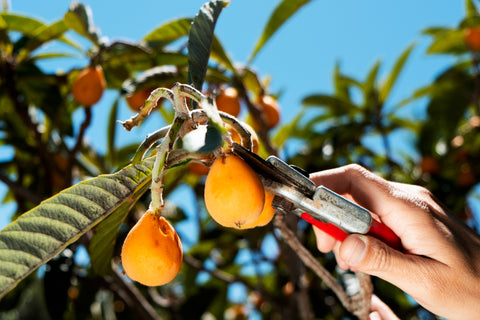
The Loquat Tree, scientifically named Eriobotrya japonica, has many names. It is also known as the Nispero, Japanese Medlar, or Japanese Plum.
Originating from China and first blooming in the late 1800s, this tree is a delightful fruit tree known for its sweet and tangy loquat fruit.
Previously grown only in China, this evergreen tree has now made its way into gardens and orchards worldwide.
✯History and Origins:
Though this fruit tree first originated in China, it was quite fast to reach other parts of the world because of its high-value Nispero fruit.
This fruit was discovered by sailors and other traders upon visits to China in the late 1800s.
They were astounded by the fruit's benefits and many qualities, and decided to take them overseas with the hopes of introducing them to their respective native lands.
In Spain, the Loquat fruit was introduced around 2,000 years back. Whereas in Japan, this was done approximately a little more than 1,000 years ago.
Today, China, Japan, and Spain are the leading producers to the Loquat fruit.
✯Things to Know: Loquat Growing Conditions
Loquat trees thrive under specific growing conditions to ensure they produce healthy and abundant fruit.
Here are some key growing conditions that suit the loquat tree, which you must make sure to follow if you want your Loquat tree to bear fruits effectively!
✦Climate
Loquat trees are subtropical and prefer a temperate climate.
They can tolerate mild winter weathers, but extended periods of cold temperatures can damage the tree.
If you live in a region that experiences harsh winters, consider planting your loquat tree in a sheltered spot or growing it in pots that can be moved indoors during cold spells.
✦Sunlight
Loquat trees require full sun exposure, which means they need at least 6-8 hours of direct sunlight each day.
Placing them in a location with ample sunlight ensures proper growth, flowering, and also fruit production.
✦Best Soil for Loquat Tree
Well-draining soil is crucial for loquat trees. They prefer loamy or sandy soil with good aeration.
Yes, they can adapt to various soil types, but it's still essential to ensure that the soil drains well to prevent waterlogged roots, in order to prevent root rot.
✦Watering
Loquat trees require consistent moisture, so you need to keep the soil consistently moist but not waterlogged.
They do become drought-tolerant once they mature but it's still important to provide regular watering, particularly during dry spells, to support fruit development.
✦Wind Protection
Loquat trees should be planted in a location sheltered from strong winds.
Wind can damage branches and blossoms, impacting fruit production.
✦Air Circulation
Good air circulation is essential to prevent fungal diseases.
Planting loquat trees in a spot with adequate ventilation will reduce the risk of fungal issues that can harm the tree and its fruit.
✦Fertilization
Loquat trees benefit from regular fertilization to support growth and fruit production.
Apply a balanced fertilizer in the spring according to fertilization instructions.
One thing you should remember is that it is vital not to over-fertilize, as this can lead to excessive foliage growth at the expense of fruit production.
✦Pruning
Pruning is necessary for shaping the tree, controlling its size, and improving air circulation.
Regularly remove dead or diseased branches and prune as needed to maintain an open canopy. Pruning should be done in late winter or early spring.
Fruit plants can be relatively easy to take care of it you know what to do. Which is why it is important to know exactly what your plant needs, what its requirements are, and what all to avoid in order to create the perfect environment for it.
Buy Fruit Plants online
By knowing and following these care tips, you should be able to help your tree bear fruits to its best capabilities.
While growing loquat trees in pots is not too big a task, you should still keep in mind its space and breathing requirements so that it can thrive.














